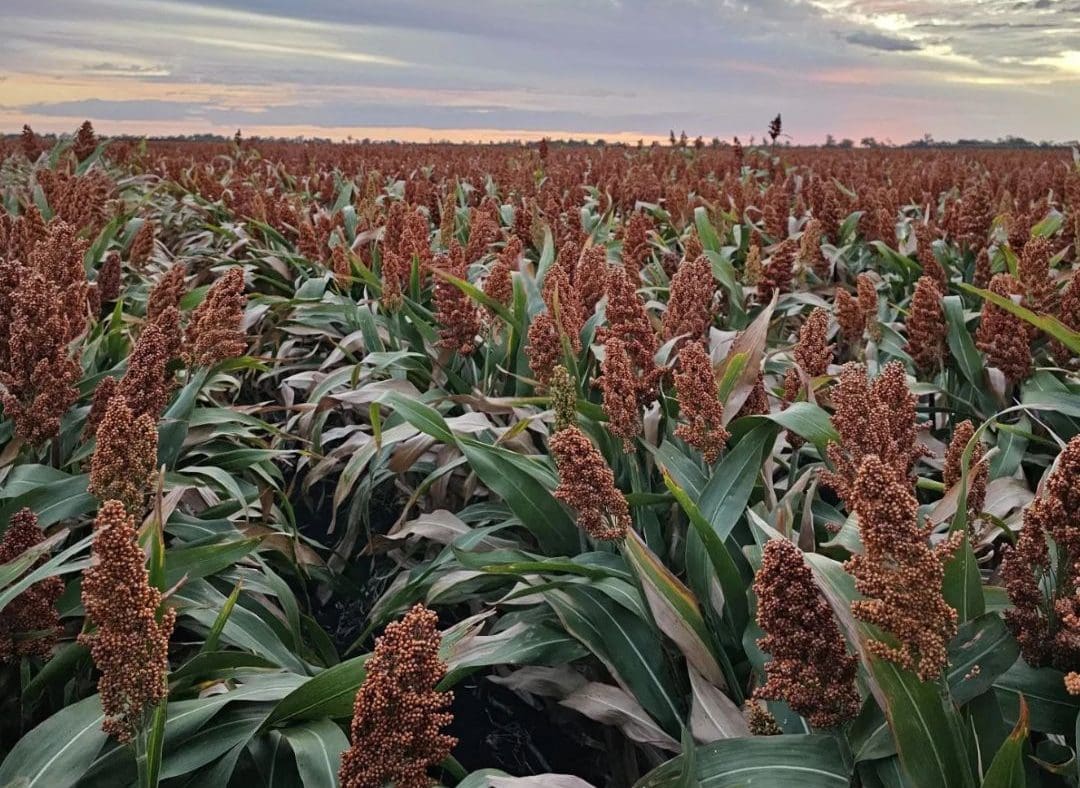
A sorghum crop prior to desiccation on Queensland’s Darling Downs. Photo: Jag Ag Contracting
BELOW-AVERAGE summer rainfall in the cropping regions of Queensland and northern New South Wales has limited prospects for summer-crop production in 2022-23, according to ABARES quarterly Australian Crop Report released today.
ABARES has forecast the sorghum crop now being harvested at 2.45 million tonnes (Mt), the fourth-largest on record, and cotton lint at 1.2Mt, the third-largest on record.
The recent unfavourable seasonal conditions have lowered soil-moisture levels, curtailed the planting of summer crops in the latter part of the planting window and adversely affected yield prospects for some dryland crops.
Earlier planted crops sown into a full profile of soil moisture have generally had good root establishment, allowing crops to draw on stored moisture during flowering and grain fill.
In contrast, yield prospects for later-sown crops have been reduced by the lack of in-season rainfall so far.
Timely and adequate rainfall over the remainder of the season will be critical to the ongoing development of dryland summer crops and prevent any further reduction in yields.
Ample supplies of irrigation water mean the recent unfavourable seasonal conditions have not adversely affected prospects for irrigated crops.
According to the latest three-month rainfall outlook to May issued by the Bureau of Meteorology on 23 February, there is a high chance that summer-cropping regions in Queensland and northern New South Wales will receive less than their median autumn rainfall.
If realised, this forecast is likely to affect the later-planted dryland crops much more than the earlier sown crops which are well into maturity.
Total summer crop production in Australia is forecast fall to just under 5 million tonnes (Mt), down by 10 percent compared to last year’s record, but remains 57pc above the 10-year average.
Falling production is driven largely by lower forecast yields offsetting increases in planted area.
Forecast yields for dryland cotton and sorghum are expected around 29pc and 14pc below last year’s record levels, but above 10-year averages.
Rice and irrigated cotton yields are forecast to remain close to 10-year averages.
Area planted to summer crops is estimated to have increased by 4pc nationally with differences across regions.
Planted area in NSW is estimated to have fallen by 2pc, limited by excessively wet conditions and flooding across major production regions during the planting window.
Planted area in Queensland is estimated to have risen by 9pc, largely due to heavy rainfall and localised flooding at the start of the winter-cropping season leaving many hectares fallow for summer crops.
Western Australia is forecast to produce 30,700t of corn in the current season, and Victoria 70,000t in addition to the dominant production in Qld and NSW.
| NSW 2021-22 | NSW 2022-23 | Qld 2021-22 | Qld 2022-23 | |
| Sorghum | 926,000 | 760,000 | 1,717,000 | 1,690,000 |
| Cottonseed | 1,005,000 | 841,000 | 508,000 | 578,000 |
| Cotton lint | 835,000 | 699,000 | 422,000 | 480,000 |
| Rice | 685,000 | 495,000 | 3,300 | 3,000 |
| Corn | 210,000 | 195,000 | 129,000 | 110,000 |
| Soybean | 41,100 | 28,000 | 15,000 | 13,200 |
| Sunflower | 22,000 | 32,000 | 7,800 | 5,000 |
Table 1: Tonnage estimates for major summer crops produced in Qld and NSW in the previous and current seasons. Source: ABARES
Source: ABARES

HAVE YOUR SAY